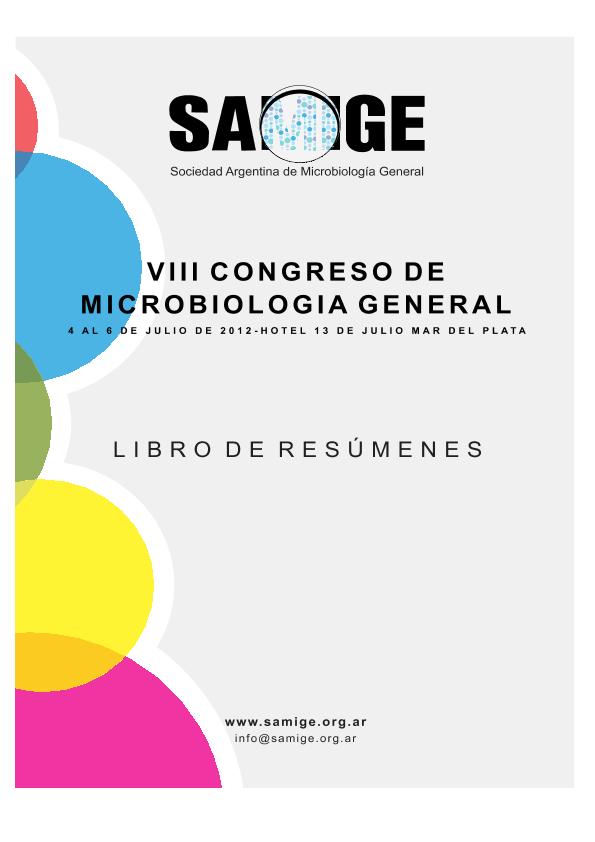Evento
Genome sequence analysis of bacteria highly tolerant to arsenic, isolated from High Altitude Andean Lakes (HAAL)
Ordoñez, Omar Federico ; Kurth, Daniel German
; Kurth, Daniel German ; Turjanski, Adrian
; Turjanski, Adrian ; Vázquez, Martin; Farias, Maria Eugenia
; Vázquez, Martin; Farias, Maria Eugenia ; Cortez, Nestor Ricardo
; Cortez, Nestor Ricardo
 ; Kurth, Daniel German
; Kurth, Daniel German ; Turjanski, Adrian
; Turjanski, Adrian ; Vázquez, Martin; Farias, Maria Eugenia
; Vázquez, Martin; Farias, Maria Eugenia ; Cortez, Nestor Ricardo
; Cortez, Nestor Ricardo
Tipo del evento:
Congreso
Nombre del evento:
VIII Congreso argentino de Microbiología General
Fecha del evento:
04/07/2012
Institución Organizadora:
Sociedad Argentina de Microbiología General;
Título del Libro:
VIII Congreso Argentino de Microbiología General
Editorial:
Sociedad Argentina de Microbiología General
Idioma:
Inglés
Clasificación temática:
Resumen
High Altitude Andean lakes (HAAL) comprise a system of shallow lakes formed during the tertiary period (1.8-65 million years ago) distributed across the Puna (high plateau) at altitudes varying from 4,200 m to 6,000 m above sea level (asl). These aquatic ecosystems present extreme environmental conditions such as high levels of Ultraviolet Radiation (UVR), a wide range of salinity (from 0.4 to 117 ppm), large daily temperature fluctuations ranging from 20° C to -40° C, low nutrient concentrations and the presence of heavy metals and metaloids, mainly arsenic. The presence of arsenic resistance mechanisms has been explored in several microbiological studies in arsenic-rich environments. The most characterized arsenic resistance mechanism is the ars operon located either in plasmids or chromosomes of prokaryotes. Bacterial As detoxification involves the reduction of arsenate (As[V]) to arsenite (As[III]) via a cytoplasmic arsenate reductase (arsC). Later on As[III] will be extruded by a membrane-associated ArsB efflux pump. Other genes like arsR, arsD and arsA form part of ars operon along with arsB and arsC in most of the As tolerant prokaryotes. HAAL isolates show enhanced resistance compared to other bacteria carrying the ars operon. This could be explained by the presence of additional genes related to this function, including extra copies of the ars operon or supplementary extrusion pumps. The aim of this study was to elucidate the genetic mechanisms of tolerance to high arsenic concentrations, taking advantage of the available genomes of three UV resistant bacterial strains, recently isolated from HAAL extreme environments. Moreover, the presence of the ACR3 gene as a possible resistance mechanism was assessed by degenerate oligonucleotides. We studied the strains Acinetobacter sp. Ver3 and Exiguobacterium sp. N30 and S17, isolated from shallow water (Laguna Verde and Laguna Negra), and from modern stromatolites (in Laguna Socompa) respectively. Maximal arsenic concentration was 33.81 mg/L. Genome sequences were obtained using a whole-genome shotgun strategy with a 454 GS Titanium pyrosequencer at INDEAR, Argentina. Genomes were annotated and analyzed in the RAST annotation server. PSI-BLAST and ClustalW were used to compare and align sequences, and phylogenetic trees were built using Mega5. The effect of As[V] and As[III] during growth in rich media was also evaluated by different protocols. The strains Exiguobacterium arantiacum DSMZ 6208 and Acinetobacter baumannii DSM 30007 were used as controls during tolerance profiles measurements. Organisms with high tolerance to this metalloid, isolated in pure culture from environments such as HAAL, could be good candidates for studies of bioremediation of metals and metalloids, a methodology considered of low cost and environmentally friendly.
Palabras clave:
GENOME SEQUENCE
,
ANDEAN LAKES
,
ARSENIC
Archivos asociados
Licencia
Identificadores
Colecciones
Eventos(PROIMI)
Eventos de PLANTA PILOTO DE PROC.IND.MICROBIOLOGICOS (I)
Eventos de PLANTA PILOTO DE PROC.IND.MICROBIOLOGICOS (I)
Citación
Genome sequence analysis of bacteria highly tolerant to arsenic, isolated from High Altitude Andean Lakes (HAAL); VIII Congreso argentino de Microbiología General; Mar del Plata; Argentina; 2012; 133-133
Compartir



